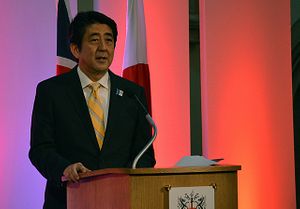In the wake of the broad agreement on the TPP reached in Atlanta on October 5, strategic competition in the Asia-Pacific has taken on two even more salient dimensions.
The first centers on competing trade models for the region. Japan wants to turn the TPP into the model for the Regional Comprehensive Economic Partnership (RCEP) and the Japan-China-South Korea FTA, while China wants these trade agreements to be modeled on the China-South Korea FTA signed in June this year, not the TPP. During the recent G20 summit meeting in Turkey, Prime Minister Shinzo Abe asserted that “The economic order built by the TPP will become the preliminary draft for the regulations for the RCEP etc.’
In the wake of the Atlanta agreement and the recent APEC meeting in Manila, both Xi Jinping and Valdimir Putin have indirectly criticized the TPP as counter to their own plans for the region. China’s position was previously cautious rather than openly negative towards the trade pact, not rejecting it outright. It remains to be seen whether the Chinese authorities will seriously consider membership, with some reports suggesting that China may now be seeing the agreement in a more positive light.
Some Chinese commentators identify the TPP and RCEP as alternative and competing routes to trade liberalization and economic integration in the region. One depicted the TPP as “powerfully promoted by the United States and excluding the two major nations China and India” and RCEP as led by ASEAN and proactively promoted by China. Such comments belie the fact that the TPP is open to Chinese membership, while the RCEP is widely seen as a China-led trade agreement even though it was initiated by the 10 ASEAN members, which invited China, Japan, South Korea, Australia, New Zealand and India – to join the negotiations.
Ultimately competition over trade agreements may determine what kind of free trade zone will prove preponderant in the Asia-Pacific as rivalry for the design of the Free Trade Agreement for the Asia Pacific (FTAAP) intensifies. Japan and the United States are explicitly pushing for the TPP to be used as the model or building block for the FTAAP, viewing the recent broad agreement on the TPP as a major step towards realizing the region-wide agreement. In the short term, trends appear to be favoring the TPP over any other FTA model, with the Philippines, Indonesia, Thailand and South Korea either expressing an interest in joining or seriously considering it. Abe was quoted on NHK News on November 20 as saying that “the new economic order [in the Asia Pacific] that will be established based on the TPP will become the springboard for rule formation in the FTAAP and reiterated that he would like to promote regional economic integration proactively with the TPP as the basis.”
In these developments, he is playing a dual leadership role with U.S. President Barack Obama in promoting the TPP around the region, causing at least one Chinese critic to ask the question: “Does Japan want to have a fall out with China in order to pander to the TPP led by the United States?” The reality is, however, that Japan is a leading power in the TPP, with Abe pursuing Japan’s own regional trade interests in promoting it as potentially a region-wide agreement.
The second dimension of strategic competition that is emerging centers on the growing importance of the TPP in terms of its geopolitical and security spin-offs. This aspect of the TPP has become much clearer in the wake of the Atlanta agreement and the recent round of summitry in Manila and Kuala Lumpur.
Obama’s overtures to non-TPP member South East Asian countries to join the pact reflects keen awareness of the TPP’s strategic value in supporting U.S. leadership in the region. He is urging more ASEAN countries to join the pact, delivering a message that the trade agreement would generate not only trade and economic benefits for member nations but also “important strategic and geopolitical benefits.”
Abe has also spoken about both the economic and strategic advantages of TPP membership at the recent meetings in Southeast Asia and expressed a keen interest in expanding participation amongst regional countries and focusing on expanding the pact.
Even before the East Asia Summit in Kuala Lumpur Abe had drawn attention to the importance of widening TPP membership as being extremely important to Japan’s security. He elaborated on this idea at the summit of TPP country leaders meeting on the sidelines of the APEC meeting in Manila, saying “deepening economic interdependence and expanding the circle of such ties will contribute to the stability of the Asia-Pacific region.” A Japanese diplomatic source explained: “Even if security problems arise amongst participating countries, they will emphasize economics and aim [to resolve issues] through peaceful processes.”
China’s push into the South China Sea is behind the growing awareness of the strategic value of the TPP and underpinning its strategic importance well beyond its significance as a trade and economic pact. Three participating countries (Brunei, Malaysia and Vietnam) have rival claims to islands and the Philippines, which is most concerned about the Chinese advance into the South China Sea, has expressed the strongest interest in joining the TPP. Member countries also share a common interest in stable sea lanes, which are indispensable for trade, so there will be incentive to coordinate in shaping regional public opinion on the issue as a possible deterrent to China.
At the same time, membership is also widely seen by both participants and non-participants as supporting U.S.-led order in the region.
Aurelia George Mulgan is professor of Japanese Politics, University of New South Wales, Australian Defence Force Academy, Canberra, Australia. Author of six books on Japanese politics (the latest “Ozawa Ichiro and Japanese Politics: Old Versus New,” Nissan/Routledge 2014).

































